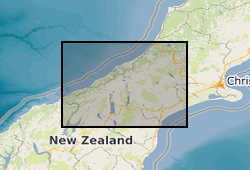Organic matter composition (isotopic composition and biomarker characterisation) from Lake Paringa and soils from Westland, New Zealand (NERC Grant NE/P013538/1)
The dataset contains geochemical measurements which quantify the amount and source of carbon in organic matter of sediments from Lake Paringa, New Zealand. Measurements were made on a 6 m sediment core collected in 2015 from the lake bed using a Mackereth corer (PA6m1a). The core was correlated to master core PA1 which has a well-established age-depth model based on accelerator mass spectrometry measurements of the radiocarbon (14C) content of terrestrial macrofossils (Howarth et al., 2016). In addition, soil samples were collected using a soil auger from two elevation transects in westland, New Zealand in 2016 and 2017 (from Mt. Fox and Alex Knob). All sediment samples were freeze dried and ground to homogenise them prior to geochemical analyses. Organic carbon concentration (%) and the stable isotopic composition of organic carbon (δ13C) was measured (Frith et al., 2018) following the removal of carbonate minerals (0.25 M hydrochloric acid for 4 hours at approximately 70 °C) by combustion of sediment at 1,020 °C in a Costech Elemental Analyser coupled via a CONFLO III to a Thermo Scientific Delta V Advantage stable isotope mass spectrometer. Total nitrogen content (N, %) and its isotopic composition (δ15N) was measured by combustion of untreated samples in a Costech Elemental Analyser with a CARBOSORB trap to inhibit large CO2 peaks from affecting measurements. A subset of samples were selected for analysis of the radiocarbon activity (14C, reported as F14C) of bulk organic matter by accelerator mass spectrometry after graphitization. A subset of sediment samples from the lake core and soil samples were selected for the analysis of biomarker abundance and their hydrogen isotope composition. We focused on the extraction of n-alkanes from aliquots of lake sediment (~2 g) using established methods (Wang et al., 2020). These measurements are reported in the dataset as the abundance of n-alkanes (chain lengths C21 to C35) in ug/g of sediment (and sum of chain lengths and ratios - carbon preference index). Finally, the dataset includes outputs of organic matter provenance: modelled elevation and depth, as described in Wang et al., (2020). In the datafile, the sample elevation and depth are provided. The labels for data are as follows. For down core sediment samples from Lake Paringa, they are labelled with the core code (PA6m1), and the sampling interval in centimetres (PA6m1_x). Soil samples from an elevation transect from Mt Fox (MF-YY-a) are labelled with a distinct code for each site (YY) and sub-code for each soil depth (a). Soil samples from an elevation transect of Alex Knob (5.Z.z) are labelled based on sub-site (Z) and soil depth (z).

dataset
:
http://data.bgs.ac.uk/id/dataHolding/13607749
English
Geoscientific information
GEMET - INSPIRE themes, version 1.0:
BGS Thesaurus of Geosciences:
NGDC Deposited Data
Biomarkers
Nitrogen
Hydrogen isotopes
Alkanes
Nitrogen isotopes
Soils
Carbon isotopes
Free:
Free:
NERC_DDC
169.0200,
-44.4900,
171.8800,
-42.5500
NEW ZEALAND [id=590000], NZ, NZL, SOUTH ISLAND [id=594000], WESTLAND* [id=594400]
creation: 2021-04-27
2014-09-01
-
2019-12-31
text table
University of Durham
Robert Hilton
Department of Geography, South Road,
Durham,
DH1 3LE
email:
not available
Role: originator
University of Durham
Robert Hilton
Department of Geography, South Road,
Durham,
DH1 3LE
email:
not available
Role: principal investigator
British Geological Survey
Enquiries
email:
not available
Role: distributor
British Geological Survey
Enquiries
email:
not available
Role: point of contact
Data Quality
For details of sample collection methods for lake sediments and soil samples, and laboratory protocols for measurements of isotopic composition and biomarker characterisation, please see the following publications: Frith et al., 2018, Nature Geoscience, doi:10.1038/s41561-018-0216-3 - available open access here - https://dro.dur.ac.uk/25874/ Wang et al., 2021, Science Advances, doi:10.1126/sciadv.aaz6446, available open access on journal page.
INSPIRE Implementing rules laying down technical arrangements for the interoperability and harmonisation of Geology
Commission Regulation (EU) No 1089/2010 of 23 November 2010 implementing Directive 2007/2/EC of the European Parliament and of the Council as regards interoperability of spatial data sets and services
Constraints
The copyright of materials derived from the British Geological Survey's work is vested in the Natural Environment Research Council [NERC]. No part of this work may be reproduced or transmitted in any form or by any means, or stored in a retrieval system of any nature, without the prior permission of the copyright holder, via the BGS Intellectual Property Rights Manager. Use by customers of information provided by the BGS, is at the customer's own risk. In view of the disparate sources of information at BGS's disposal, including such material donated to BGS, that BGS accepts in good faith as being accurate, the Natural Environment Research Council (NERC) gives no warranty, expressed or implied, as to the quality or accuracy of the information supplied, or to the information's suitability for any use. NERC/BGS accepts no liability whatever in respect of loss, damage, injury or other occurence however caused.
Available under the Open Government Licence subject to the following acknowledgement accompanying the reproduced NERC materials "Contains NERC materials ©NERC [year]"
licenceOGL
Metadata about metadata
c1a62e54-49e0-207d-e054-002128a47908
British Geological Survey
Environmental Science Centre,Keyworth,
NOTTINGHAM,
NG12 5GG,
United Kingdom
tel: +44 115 936 3100
email:
enquiries@bgs.ac.uk
Role: point of contact
2024-04-17
